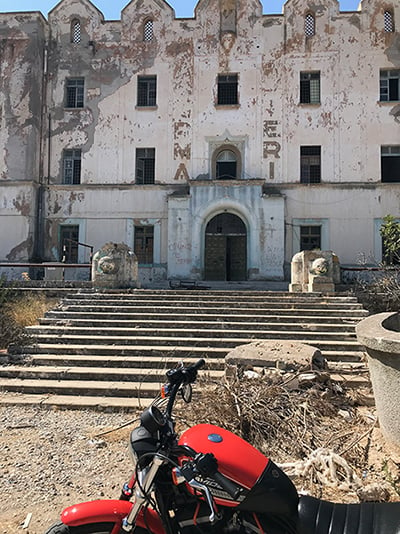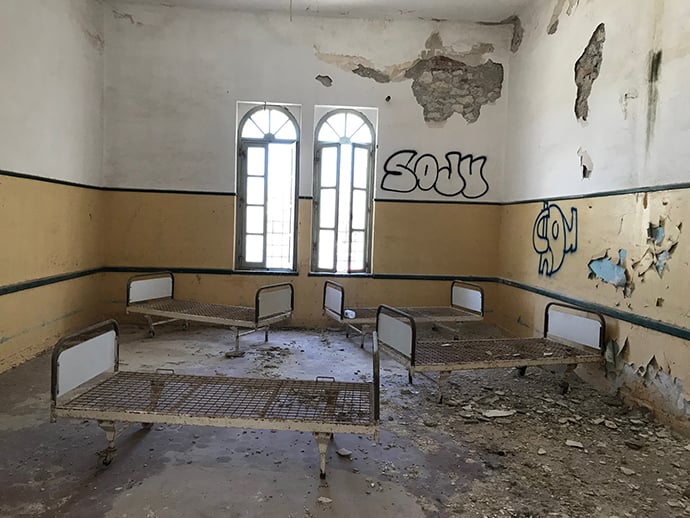I approached the refugee camp from above, on the back of a Harley-Davidson. Beyond loops of barbed wire, aquamarine Aegean waters lapped at a white pebble cove and goats bleated among pine trees fringing the shore. I was on the west coast of Leros, on my way to a camp housing around seven hundred asylum seekers from Syria, Afghanistan, Libya, and Sudan, waiting to be shipped to Athens.
The humid air smelled of salt and resin. As I approached the gates, an abandoned building caught my attention: a once-imposing façade, bleak and institutional, several stories high. Peeling white paint with faded, indecipherable letters ran down the huge front door. I felt a guilty curiosity, momentarily distracted from the refugee camp.
Italy occupied Greece’s Dodecanese islands from 1912 to 1943, and this building had been constructed during the 1930s as barracks for Mussolini’s soldiers. The Italians left in 1943, and in the late 1950s, the Greek government converted the barracks into a psychiatric asylum. Thousands of the country’s most unstable patients, deemed incurable, were brought here by boat. By the 1980s, British newspapers were reporting that patients were kept naked and chained to the walls by untrained locals commandeered as staff. In 1989, the BBC labelled Leros “the island of the damned.” A wave of international condemnation followed, forcing the government to close the main facility.
At the height of the refugee crisis in early 2016, boats from Turkey carrying asylum seekers arrived in Leros nearly every day. The municipal authorities built a “hot spot”—a first reception facility, not meant to be permanent accommodation—to process the arrivals quickly. On an island about the size of Manhattan, the obvious place to build the camp was on the old grounds of the asylum, out of sight of residents and tourists.

The facade of the asylum, built in the 1930s as barracks for Mussolini’s soldiers.
I had visited overcrowded camps like Moria, on the island of Lesbos, and was skeptical of reports that the facility on Leros was any different. The thick-necked, medallion-wearing owner of my hotel, Stavros, had offered to take me to have a look—“I know the guards, no worry”—and so I found myself on the back of his motorcycle, wary of his overfriendliness. The island’s police chief welcomed us through the double-gated entrance, waving away my press card and greeting Stavros with a huge smile. In Greek, she told the guards to take me on a guided tour, like a proud host showing off a new home.
The camp was neat and quiet, most families hidden inside individual, prefab housing units, each with an air-conditioning unit whirring outside. The sound of children’s voices came from one; peering inside, I made out a tiny classroom decorated with the letters of the Greek alphabet, children of varying ages shouting from desks. Clearly, there had been some concessions made for residents. The guards pointed out the Wi-Fi antenna on the roof of the central, administrative unit. “This is like hotel, every service you want!” they joked, laughing and stopping to light cigarettes. They had given up on the tour. The few refugees I passed were on their way to the gate to sign out on “day release”; one young Syrian man told me he was going to work. I asked him what that was. He smiled, hesitant with his English. “I help an old lady with her garden. She pay me a little.” I watched as he joined the queue at the gate—he would be back at dusk, preferring the security of the camp and the potential for a fresh start in Europe to a lifetime spent illicitly gardening on this tiny island.
The camp was worlds away from Moria, vast and squalid with its flimsy nylon tents spilling over each other, soldiers patrolling the perimeter, pregnant women and vacant-eyed men crowded together. One important difference was size—the Leros camp rarely holds more than a few hundred people, as the police chief told me, whereas Moria houses thousands. On Leros, there was less of a fight for space and food; there were funds for a school, and relatively quick processing times. There was a sense of almost disquieting order: everything was, superficially at least, under control. I sensed there was another reason for the professionalism of the place, and it had something to do with the ghostly presence of the building beyond the camp’s perimeter.
I walked up the steps of the disused asylum with Stavros just behind me, declaring his intention to “protect me”—we had been warned by the guards at the migrant camp that ex-patients still occasionally sleep in the building, returning by force of habit and a perverse sense of home. As we entered the hall, the cicada-throbbing heat disappeared. A marble staircase stretched upward, covered in rubble and dried bird droppings. We stood still, absorbing the silence and adjusting to the gloom. An ornate iron grill separated the stairwell from the hall. On the first landing, I spotted an abandoned leather shoe and some striped trousers, crumpled and covered in dust. I walked gingerly through a corridor to my right, my shoes crunching on the debris. Stavros followed too closely behind.

Graffiti left by former patients.
I hurried out of his reach, passing a pile of yellowing papers covered in Greek script, old doctor’s notes. Stavros stooped to examine them. I walked purposefully into a large room with wild drawings of naked men and women sketched onto the walls and “never foget” scrawled in blue paint. I stopped to take a photo and heard a click behind me: Stavros taking a photo of me taking a photo. He grinned as I turned around, startled. I slipped through a gap in the wall, up the stairs, into another room: an old dormitory filled with the iron skeletons of wheeled beds, a stove, a pack of cigarettes on the floor. A pigeon burst from a rafter overhead.
Then I heard Stavros again, puffing on the final step. I entered another room—full of rusting kitchen equipment—almost running, more afraid of the sweaty man behind me than the deserted asylum, claustrophobia mounting. Above my head, a rusty drying rack hung from the exposed bricks of the ceiling. I looked behind me: Stavros emerged through the broken panes of glass in the door like Jack Nicholson. In front of me, a window covered by a grill. I walked toward it and looked out through the bars: the refugee camp, and beyond, the glittering sea. History repeats itself: the unwanted confined under the guise of protection. Around the camp’s perimeter I could see megaphones: the guards’ instructions bellowed out periodically, just as they would have for the patients in this building. Suddenly, there was a hand on my shoulder, then his mouth on my back. I jerked away. He shouted after me as I hurried down the stairs: “You no tell no one! I have a wife.”

Skeleton bed frames in the old dormitory of the abandoned asylum.
The next day, I left the hotel before breakfast and rented my own motorbike. I wanted to revisit the asylum alone. I drove cautiously through the unattended gates of the hospital compound; instead of taking the road to the refugee camp I drove left, past small buildings with verandas—the houses Mussolini had built for his officers, near the barracks. I had not anticipated that the hospital still functioned; I drove carefully past patients wandering under cypress trees. I came to what looked to be the main office and stopped. Inside, a brisk, middle-aged woman looked at me in surprise and invited me to take a seat.
Carolina Baes was appointed director of the hospital thirty years ago: her job was to shut down the main asylum and house the remaining two hundred and fifty patients in the more humane accommodations nearby. I found myself telling her about my little sister, who has borderline personality disorder and has been in several high-security institutions since the age of fifteen. I asked about the lack of security, and questioned why I could drive my motorbike in unchallenged. I was uncomfortably aware of the indignation in my own voice.
Baes was brisk, professional, unfazed by my emotion: she told me that the first thing she did when appointed was tear down the fencing surrounding the complex, an attempt to remove the stigma that patients were “untouchables.” She admitted that as a consequence several patients drowned in the sea, but she seemed oddly at peace with this collateral damage. She was less accepting of the new refugee camp next door, but speculated that the reason Leros experiences less friction than other Greek communities that have come to support refugee camps is that her island is used to housing populations it knows to be different.
Later that afternoon, I drove back to the abandoned asylum building. Without Stavros, I felt vulnerable in a different way. I climbed the marble steps again, and found myself filming a little video on my phone as I retraced my steps, glancing from the grimy walls to the screen, jokingly referencing horror films as I picked my way through the bird droppings, past the pile of doctor’s notes—a way to keep up morale.
I made myself climb the stairs, visit the same dark rooms, pause in the old dormitory to imagine the horror of sleeping there, the shrieks of other patients, the smell, the indignity. As I finally left through the main door, I tried not to break into a run, breathing the warm air as I stepped outside. Adjusting to the light again, I caught sight of a figure stumbling unsteadily toward me: an old man dressed only in shorts, muttering to himself and grinning. I slipped into the shade of a nearby tree and watched as he approached the front door: an old patient, probably living in the new building nearby. “Sometimes they try to get into the refugee camp,” Baes had told me, matter-of-factly. “They are attracted by the sound of voices and sense of community, so they ask the guards to let them in.”


